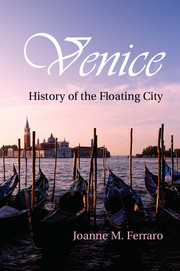Book contents
- Frontmatter
- Contents
- Plates
- Illustrations
- Maps
- Acknowledgments
- Preface
- Chronology of Historical Events
- 1 Reconstructing the Floating City
- 2 The Riches of Asia, Europe, and North Africa
- 3 A Pride of Lions
- 4 Identities and Modes of Socialization
- 5 Material Life
- 6 City of Myth
- 7 The Serenissima’s Wayward Subjects
- 8 The Baroque Stage
- 9 Epilogue
- Appendix I Approximate Population of Venice during the Republic
- Appendix II Population of the Historic Center of Venice, 1871–2010
- Glossary
- Notes
- Bibliography
- Index
- Plate Section
- References
5 - Material Life
Published online by Cambridge University Press: 05 August 2012
- Frontmatter
- Contents
- Plates
- Illustrations
- Maps
- Acknowledgments
- Preface
- Chronology of Historical Events
- 1 Reconstructing the Floating City
- 2 The Riches of Asia, Europe, and North Africa
- 3 A Pride of Lions
- 4 Identities and Modes of Socialization
- 5 Material Life
- 6 City of Myth
- 7 The Serenissima’s Wayward Subjects
- 8 The Baroque Stage
- 9 Epilogue
- Appendix I Approximate Population of Venice during the Republic
- Appendix II Population of the Historic Center of Venice, 1871–2010
- Glossary
- Notes
- Bibliography
- Index
- Plate Section
- References
Summary
Turning Tides
The Republic’s commercial expansion reached the height of its development in the mid-fifteenth century. By then the Ottoman gaze rested firmly on Venice’s seaborne empire. With a storm brewing on the horizon, the Venetians added two new sea routes. The first transported slaves, gold, hides, and cereals from sub-Saharan to North Africa, stopping in southern Spain and Barcelona and then heading south to Sicily and Tunis before returning to Venice. (See Map 2). The second docked at Alexandria, Tunis, and the Barbary coast. However, the submission of Constantinople to the Turkish Sultan Mehmed II in 1453 made Venice’s position on the Aegean and the Adriatic tenuous. At first, diplomacy prevailed, but by the end of the century the Republic was engaged in a costly war (1499–1503). Modone and Corone fell to the Ottomans, who then went on to conquer Syria and Egypt in 1517. Another war broke out between 1536 and 1540, with Venice losing the Morea and the duchy of Naxos to its political nemesis. Thirty years later, Cyprus also came under Ottoman rule, despite the Christian victory of the Holy League of Venice, Spain, and the pope at the Battle of Lepanto (1571).
Despite the series of reversals, Venice enjoyed commercial vitality through the sixteenth century, thanks to the ef orts of diplomats, merchants, laborers, and pilgrims. Moreover, the economy thrived at home, with one of the strongest industrial bases in Europe. Venice continued to be a powerful magnet for immigration , capable of strengthening its labor force even in the face of dramatic demographic l uctuation. In preparation for the Battle of Lepanto in 1571, for example, the Venetians built a hundred galleys with the aid of more than 2,000 arsenal workers. The plague of 1576–7, however, produced a dramatic setback, reducing the population of 168,000 to around 120,000, but by 1586 the number had climbed to 148,000. The thriving industrial base attracted droves of foreign peoples searching for employment in the merchant fleet and the navy, where new ships carrying cannon were being built; in port services; and in the crafts.
- Type
- Chapter
- Information
- VeniceHistory of the Floating City, pp. 106 - 124Publisher: Cambridge University PressPrint publication year: 2012



